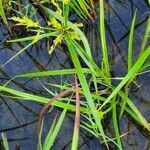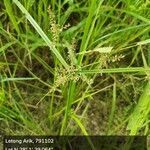Annuals. Roots fibrous. Culms tufted, 8-80 cm tall, slender to slightly stout, compressed triquetrous, base few leaved. Leaves much shorter than culm; sheath reddish brown to brownish purple; leaf blade 2-5 mm wide, slightly folded or flat. Involucral bracts 3-5, leaflike, lowermost 2 or 3 longer than inflorescence. Inflorescence a compound or rarely simple anthela; rays 4-9, mostly to 12 cm, each with 5-10 or more spikes. Spikes ovoid to oblong-ovoid, 1-4 cm, with 5-20 or more spikelets. Spikelets laxly arranged, ascending to slightly spreading, narrowly ovoid, very narrowly ovoid, or oblong, 4-10 × ca. 2 mm, compressed, 6-22-flowered; rachilla almost wingless, with successive glumes 0.7-0.9 mm apart. Glumes yellow to straw-colored, lax, broadly obovate, ca. 1.5 mm, membranous, 3-5-veined, keel middle abaxially green, margin apically white hyaline, apex retuse and mucronulate. Stamens 2(or 3); anthers ellipsoid; connective not prominent beyond anthers. Style very short; stigmas ± short. Nutlet dark brown, obovoid to subellipsoid, 1.2-1.4 mm, nearly as long as subtending glume, 3-sided, densely prominently puncticulate. Fl. and fr. Jun-Oct. 2n = 108, 112, 116, 128.
Herbs, annual, cespitose. Culms trigonous, (5–)20–60 cm × (0.2–) 0.6–2.4 mm, glabrous. Leaves (1–)3–4, V-shaped, 15–40 cm × 3–6 mm. Inflorescences: spikes 2–5(–8), oblong to ovoid, 2–10 cm × 3–12 mm; rays 4–8, to 11 cm; bracts (4–)5(–7), ascending at 45°, V-shaped, (1.5–)8–30(–50) cm × 1–6 mm; rachilla persistent, wingless (successive floral scales 0.7–0.9 mm apart). Spikelets 10–30, compressed, linear to ellipsoid, 4–20 × 1.5–2.1 mm; floral scales deciduous, (2–)6–26, laterally brown to golden brown, edges clear, medially green, 5-ribbed, outermost ribs more noticeable than others, obovate to nearly orbiculate, 1.3–1.8 × 1.2–1.8 mm, margins emarginate, apex with mucro 0.05–0.12 mm. Flowers: stamens 2(–3); anthers (0.2–)0.3–0.4 mm, connective tips reddish, less than 0.1 mm; styles less than 0.1 mm; stigmas 0.2–0.4 mm. Achenes brown, slightly stipitate, obovoid, 1.2–1.4 × 0.5–0.7 mm, apex apiculate, surfaces puncticulate.
Tufted annual to 6 dm, with rather short, basally disposed lvs; rays usually well developed and commonly branched at the top; spikes loose and open, 1–2 cm, bearing several rather distant, ascending spikelets; spikelets 10–20-fld, to 1 cm; rachilla persistent; scales broadly obovate, rounded-emarginate, scarcely mucronate, 1.2–1.7 mm, with green midrib and golden-brown sides; rachilla wingless; stamens 2 or 3; achenes trigonous, 1–1.5 mm, blackish. Swamps and muddy ground; native of Eurasia, intr. in se. U.S. as far n. as s. Ill., Ky. and se. Va.
Annual herb, up to 0.6 m high. Inflorescence an open anthela, 15-200 x 10-200 mm, with groups of spikes sessile or on long peduncles. Glumes with an uncoloured margin and a greenish, slightly excurrent midrib, golden brown.
Obtuse, golden, very compressed spikelets in oblong, erect spikes
Annual up to 76 cm. high







